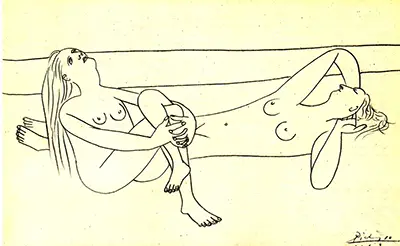Picasso's drawings - Most people consider Picasso's most important works to be his paintings. However, Picasso said to his art dealer, Daniel Henry Kahnweiler, that drawing, due to its immediacy, was more important for the artistic representation of ideas. He was taught to draw by his father and showed great ability even as a child. Throughout his life he made line drawings based on mythology, animals and the human form. His genius was in not losing his subject's vitality even when using a minimal number of lines. Some of these drawings show more detail and realism than others.
The period around 1920 for Picasso - The year, 1917, seemed to change Picasso both personally and artistically. In that year he went to Italy where he met both Stravinsky and his future wife, Olga Koklova. He was involved in theatre scene painting and felt a need to explore many forms of art. He had been a cubist, a famous painting of his being Les Demoiselles d'Avignon painted in 1907. After 1917 his vision became less analytical and dissecting and he became interested in what was known as naive art. The simplicity of this art appealed to Picasso who made many line drawings that are still popular today.
Nudes in Reverie - In this line drawing there are the simplest outlines of two female nudes, one lying down on her back with her hands behind her head and the other sitting awkwardly cross-legged in front of the first figure's legs. The feet of the first figure delightfully appear from behind the second figure. The women's breasts are depicted by just semi circles and dots and the heads of both figures are thrown back in daydream. Interestingly, Picasso made another line drawing of a lone female nude lying the other way round. In Nudes in Reverie there are two parallel lines behind the two figures whose reverie is captured by Picasso's crisp lines and his ability to know the essential details needed to express the scene's atmosphere.

